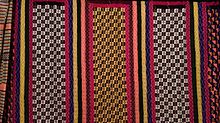Musée national du Mali
National Museum of Mali is the archaeological and ethnographic National Museum of the Republic of Mali . It is located in the capital Bamako . It presents permanent and temporary exhibitions with a focus on the prehistory of Mali as well as musical instruments, ritual objects, objects and clothing from the country's different ethnic groups .
history
The history of the museum began under French colonial administration as the Sudanese Museum and was part of the "Institut Français d'Afrique Noire" (IFAN) under the direction of Théodore Monod . The opening took place on February 14, 1953. Under the direction of the Ukrainian archaeologist Yuriy Shumovskyi, who worked as an archaeologist in Mali for nine years, a collection was created that makes up more than half of the approximately 3,000 artefacts that are today .
With the independence of the Republic of Mali in 1960, the Sudanese Museum became the National Museum of Mali with the new objectives of promoting national unity and honoring Malian traditional culture. The museum's collections have been neglected due to the lack of financial resources and qualified personnel. In 1966 the National Museum moved to a new building, which was built by the architect Jean-Loup Pivin in the traditional Malian design of an adobe building with exhibition rooms, cafeteria and library .
Since the election of the former archaeologist Alpha Oumar Konaré as President of the Republic of Mali, the museum has received significantly higher funding in 1996 and has thus become one of the most important museums in West Africa . Since 1994 the museum has also been the exhibition venue for the “Rencontres africaines de la photographie” biennial , an exhibition with exhibits by contemporary African photographers.
In the years 2001 to 2003, under the leadership of the museum director Samuel Sidibé, major renovations and extensions took place. Among other things, a temporary exhibition hall, an open-air area with reconstructed villages, technical and administrative premises and a complete restructuring of the museum were created. In 2006, the National Museum was awarded the Prince Claus Prize in recognition of its efforts to promote cultural heritage .
In June 2006, an agreement on cooperation with the " Aga Khan Trust for Culture " (AKTC) was signed. Among other things, the memorandum provides for the museum to be equipped with a new information technology system that enables a digital database of the museum's collections and digital archiving of images and audio files. The technical equipment, software and training are provided by the AKTC.
Web links
- Photo collection Musée national du Mali on archnet.org, accessed on August 9, 2013.
Individual evidence
- ↑ Африканські пригоди волинського археолога Юрія Шумовського on uaworon.livejournal.com (Ukrainian), accessed August 9, 2013.
- ↑ Samuel Sidibé, Director (PDF; 27 kB) on unesco.org, accessed on August 9, 2013.
- ^ Aga Khan Development Network on akdn.org, accessed August 9, 2013.
Coordinates: 12 ° 39 ′ 31.1 ″ N , 7 ° 59 ′ 57.5 ″ W.

